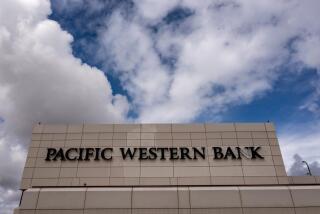Big Banking Is Not Necessarily Bright Banking
- Share via
If we keep this up, will five or six giants eventually rule American banking? The reference, of course, is to the competitive mating of the big bank holding companies in Texas this week.
After Chairman Ben F. Love stole a march on his competitors by selling Houston-based Texas Commerce Bancshares to Chemical New York Corp. on Monday, the two big Dallas-based banking companies--RepublicBank and InterFirst--announced a merger on Tuesday.
It was something they had to do rather than allow Love’s bank to gain a competitive advantage in the Texas market, where the economy--and, by extension, all the banks--have been hard hit by falling oil prices. With the backing of $57-billion (assets) Chemical New York, Texas Commerce could pay less interest to attract deposits and gain an edge in pricing its loans.
Give Love credit for recognizing that with interstate bank competition bound to come to Texas (the state Legislature passed a law allowing it in August), a wounded local institution standing on its own would find it tough to do more than merely survive.
Allied Bancshares, one of the smartest Texas banks, is actively seeking an interstate backer for the same reason, and other mergers are sure to follow.
Trend Is Nationwide
Nor is Texas alone. The trend is nationwide. On Wednesday, for example, Oregon’s U.S. Bancorp announced that it is buying Old National Bancorporation of Spokane, Wash. In the last year, Ohio banks have moved into Indiana, North Carolina banks into Georgia and Massachusetts’ Bank of New England merged with Connecticut Bank & Trust.
The same Chemical New York that is acquiring Texas Commerce has already signed letters of intent to acquire banks in New Jersey and Florida when state laws permit.
Which raises the question: Is there any future for the small local bank? Or will it go the way of the mom-and-pop grocery store--bulldozed by the supermarket?
Hold the funeral wreath. The answer is yes, of course, there is a future for small local banks and for a lot of other banks, too.
We’ll probably never see a U.S. national banking system dominated by half a dozen institutions, similar to the systems of Canada and Britain. Why not? For one thing, because we like having a lot of banks in this country.
State and federal laws make it such an easy business to get into that real estate developers and car dealers traditionally form banks to help finance themselves. And if a lot of banks fail, new banks are formed to replace them.
More Than 14,000 Banks
There are more than 14,000 banks now. There were more than 14,000 a decade ago, when financial deregulation was becoming a fact, and there were more than 14,000 in 1934, when the Federal Deposit Insurance Corp. was set up.
For another thing, big is not the same as bright, especially in banking, where smaller banks are often far more profitable than stumbling giants.
Scan the quarterly bank ratings put out by such firms as Sheshunoff & Co. of Austin, Tex., and you’ll notice that banking companies such as Pennsylvania’s PNC Financial or Wisconsin’s Marshall & Ilsley earn far more on assets and stockholders’ equity than such big names as Citicorp and Chase Manhattan.
Some of that profitability, to be sure, results from the lack of intense competition--laws against interstate banking historically providing a shelter for the locals--but not all of it. Most of a good regional or local bank’s profitability probably comes from knowing its market and running a tight shop. Local, in short, can be beautiful in banking.
So why are all these banks merging across state lines? For geographic diversification to spread the risk, among other reasons.
Don’t forget, the Texas banks weren’t the only ones hit by the state’s declining economy. The big New York and California banks have been in Texas for years, with loan production offices, leasing subsidiaries and every sort of banking service--save taking deposits, which wasn’t then legal. Were they able to avoid the kind of bad loans that hurt the native banks, do you think? Did they lend to oil drillers or the sugar plum fairy?
But unlike the local banks, the outlanders could make profits elsewhere large enough to offset their Texas losses. Now they are trying to gauge just how much they should pay and when they should pay it to acquire a Texas bank and gain full entry to what surely will be again one of the nation’s greatest markets.
The real shape of the future in banking? Don’t think of mom-and-pop grocery stores. Think of the supermarket industry, where local and regional chains lead in every market and the two attempts at national chains--A&P; and Safeway--were almost never better than also-rans and now are in retreat. Big was not the same as bright there either.
More to Read
Inside the business of entertainment
The Wide Shot brings you news, analysis and insights on everything from streaming wars to production — and what it all means for the future.
You may occasionally receive promotional content from the Los Angeles Times.










